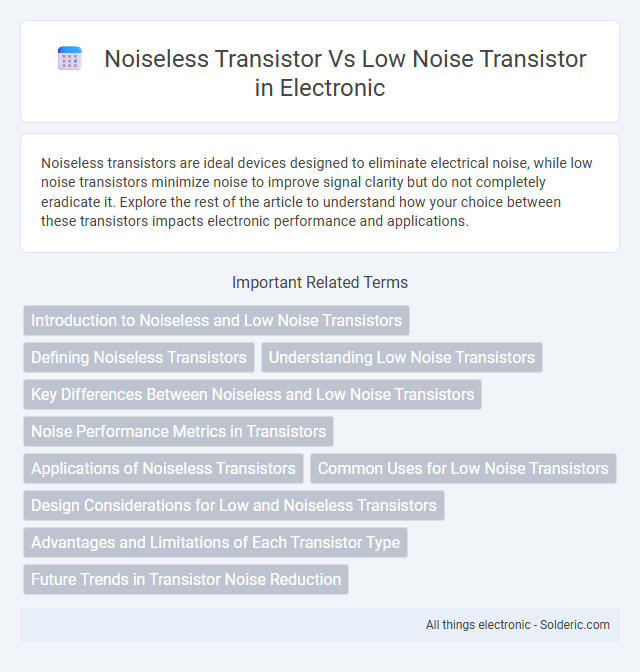Noiseless transistors are ideal devices designed to eliminate electrical noise, while low noise transistors minimize noise to improve signal clarity but do not completely eradicate it. Explore the rest of the article to understand how your choice between these transistors impacts electronic performance and applications.
Comparison Table
| Feature | Noiseless Transistor | Low Noise Transistor |
|---|---|---|
| Noise Level | Virtually zero noise generation | Minimal, but measurable noise |
| Application | High-precision sensor circuits, quantum computing | Audio amplifiers, RF receivers, low-noise amplifiers |
| Technology | Advanced materials and quantum designs | Optimized semiconductor doping and structures |
| Cost | High due to complex manufacturing | Moderate, suitable for commercial use |
| Availability | Limited, specialized market | Widely available in various specifications |
| Performance | Exceptional signal integrity, near-zero noise floor | Improved signal-to-noise ratio compared to standard transistors |
Introduction to Noiseless and Low Noise Transistors
Noiseless transistors are theoretical devices designed to operate without generating intrinsic electrical noise, aiming to achieve ideal signal amplification. Low noise transistors, such as low-noise bipolar junction transistors (BJTs) and low-noise MOSFETs, minimize noise figure and improve signal-to-noise ratio in sensitive electronic applications like RF communication and sensor circuits. Advances in semiconductor materials and fabrication techniques enhance the noise performance of low noise transistors, making them essential for high-precision analog and microwave systems.
Defining Noiseless Transistors
Noiseless transistors are idealized components designed to minimize electrical noise generation, enhancing signal clarity in sensitive electronic applications. Unlike low noise transistors, which reduce noise to a certain extent through material composition and construction, noiseless transistors aim to approach the theoretical limit of zero noise. Your choice between these technologies depends on the specific noise performance requirements of your circuit design.
Understanding Low Noise Transistors
Low noise transistors are specifically engineered to minimize the intrinsic electronic noise generated during signal amplification, which is crucial for high-fidelity applications like RF communication and sensitive instrumentation. Understanding low noise transistors involves analyzing key parameters such as noise figure, gain, and bandwidth to optimize your circuit's overall signal-to-noise ratio. Unlike noiseless transistors, which are theoretical ideals, low noise transistors offer practical performance improvements that significantly enhance your device's clarity and reliability.
Key Differences Between Noiseless and Low Noise Transistors
Noiseless transistors are designed to theoretically eliminate electronic noise, achieving near-zero noise levels ideal for ultra-sensitive applications such as quantum computing and precision instrumentation. Low noise transistors, while not entirely noise-free, significantly reduce noise generation compared to standard transistors, making them suitable for audio amplifiers, RF circuits, and high-frequency communications. The key difference lies in the noise floor, with noiseless transistors offering near-ideal noise performance, whereas low noise transistors provide a practical balance between noise reduction and cost-efficiency.
Noise Performance Metrics in Transistors
Noise performance metrics in transistors primarily include parameters such as noise figure (NF), noise voltage, and noise current spectral densities. Noiseless transistors, though idealized, represent devices with minimal intrinsic noise contributions, enabling near-perfect signal amplification, whereas low noise transistors are specifically engineered to minimize noise figure and enhance signal-to-noise ratio (SNR) in practical circuits. Key metrics include thermal noise, flicker (1/f) noise, and shot noise, with low noise transistors optimized by material choice and structural design to suppress these noise sources for applications in RF and sensitive analog front-ends.
Applications of Noiseless Transistors
Noiseless transistors are primarily utilized in high-frequency applications such as RF amplifiers, satellite communications, and sensitive signal processing due to their minimal noise generation, which preserves signal integrity. Their ability to maintain ultra-low noise figures makes them ideal for use in precision instrumentation, including medical imaging devices and scientific measurement equipment. In contrast to low noise transistors, noiseless transistors offer superior performance in environments requiring exceptionally high signal-to-noise ratios.
Common Uses for Low Noise Transistors
Low noise transistors are primarily utilized in high-frequency applications such as radio receivers, satellite communications, and sensitive amplification circuits where signal clarity is crucial. These transistors excel in minimizing electronic noise, enhancing the performance of RF amplifiers, and improving the detection of weak signals in wireless communication systems. Noiseless transistors, though ideal in theory, are rare and typically serve specialized roles in ultra-low noise environments like precision instrumentation.
Design Considerations for Low and Noiseless Transistors
Design considerations for low noise and noiseless transistors prioritize minimizing intrinsic electronic noise through material purity, optimized doping levels, and precise geometric configurations. You must focus on reducing thermal and flicker noise by selecting appropriate semiconductor substrates and employing advanced fabrication techniques such as ion implantation and surface passivation. Achieving near noiseless performance requires meticulous control over carrier mobility and junction characteristics to enhance signal integrity in sensitive analog applications.
Advantages and Limitations of Each Transistor Type
Noiseless transistors offer the advantage of virtually eliminating signal interference, making them ideal for ultra-sensitive applications like quantum computing and high-precision sensors, but they often require complex fabrication techniques and can be cost-prohibitive. Low noise transistors provide significantly reduced noise levels compared to standard transistors, enhancing signal clarity in RF and audio equipment while maintaining more accessible manufacturing processes and cost-effectiveness. However, low noise transistors still generate some intrinsic noise, limiting their performance in extremely noise-sensitive environments where noiseless transistors would be preferred.
Future Trends in Transistor Noise Reduction
Future trends in transistor noise reduction emphasize advancements in material science and device engineering to enhance signal integrity and minimize thermal and flicker noise. Innovations such as semiconductor heterostructures, graphene-based channels, and quantum tunneling transistors promise lower intrinsic noise levels supporting high-frequency and low-power applications. Your choice between noiseless transistors and low noise transistors will increasingly depend on specific application requirements, as emerging technologies push the boundaries of minimal noise performance.
Noiseless transistor vs Low noise transistor Infographic

 solderic.com
solderic.com